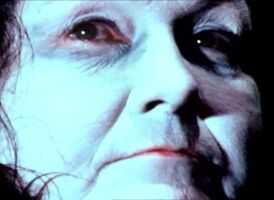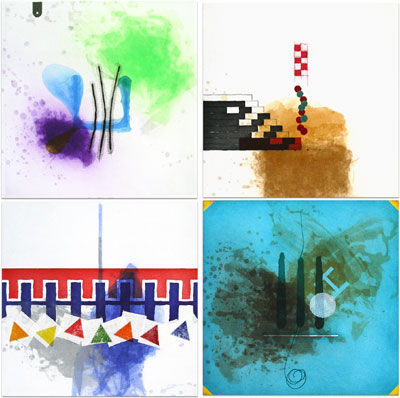
For falsehood, falsehoods of generation, and corruption, the perfect inorganic (Nietzsche), the imperfect organic, who rise from colors, the colors of the false, who rise bed-ridden, false seed relation, of generation and false corruption, the non- corrupt, the renewed innocent...
Men then bear their own fathers… But it is not so simple as Kierkegaard would make out, in all of his paradox and contradiction -- his standstills; since Kierkegaard’s generations still rest on an Aristotilean genealogy, on “family trees” and re-productive “organicisms”. Men then bear their fathers, but they only resurrect themselves once (as Deleuze’s points out in *Logic of Sense)*; Kierkegaard is prey to Abrahamism as an (onto)logical paradox of heredity and generation. That one bears their own father, but also that one sacrifices the created to continue living.
There is something peculiar, something "out-of-joint," about David Lynch’s animated seed beds throughout his early shorter film, *The Grandmother*, from which "human beings" behaving as dogs apparently sprout: that trees typically give birth in linear, bifurcating generations (the “family tree”), but do so non-linerally (and thus falsely?) in Lynch’s third short film. Is *The Grandmother* then not a film concerning rhizomatic generations? A nomadology of seedlings? “The wisdom of the plants: even when they have roots, there is always an outside where they form a rhizome with something else – with the wind, an animal, human beings. … Follow the plants: you start by delimiting a first line consisting of circles of convergence around successive singularities; then you see whether inside that line new circles of convergence establish themselves, with new points located outside the limits and in other directions.(*A Thousand Plateaus*, 11)”
Perhaps. But then Lynch’s world in *The Grandmother* seems archetypal, “preformalist,” and atomistic more than anything else. Lynch says of his first film that he came about it in an attempt to make his paintings "move," that is to animate them. What is animation but a truer limit of cinema as false generation of movement (Bergson), or as an atomization of time by frame rate? False time, false motion, false generation. *The Grandmother* is the second of two films that move from the pure animation of his first, *Six Men Getting Sick (Six Times)*, towards a complex (however much intuited and post-"psychadelic") blend of diegetic elements with extra-diagetic and animation techniques.
The fact of tree / seed growth belies an inorganicism or organicism of the falsely generated, non-linear and preformalist. And we can oppose the false generations (the immaculate conceptions?) of Lynch’s films to the inorganicism of the “crystal images” of *Cinema 2*, by which images are generated in a duality constitutive of the "falseness" of actuality in relation to the "phantasmic" opacities of the virtual. This "falseness" of crystallic-virtualism – a virtualism which rests on Bergson’s crucial distinction between the dyadic terms *real* / *possible* and *actual* / *virtual* – we should distinguish from preformalist (in-)organism. Where crystallic-virtuality presupposes Bergson’s method of “philosophical intuition” – creative evolutions within tendential forms - preformalism assumes organicity as a consequence of the realization of existing potential forms. That is, realized organisms are the copies of possible forms. Such a view of creation may assume, following Jalal Toufic’s own atomistic view of cinema in his essay, “Before thy Gaze Returns to Thee,” that creation is non-continuous or *renewed* during each "subsequent" instance.
Non-continuous creations, like Lynch’s “seed,” know no continuous generationality. Rather, a seed remains a “person” in potentia until planted in the ground and watered; therefore, the generations between seeds remain horizontal, discrete, and non-chronological / non-linear. However a vertical dimension does assert itself in the set and animation segments of *The Grandmother*: initially, in order to abscond from his belligerent "father," the "grandson" / boy acsends upwards from his sprout-bed; also, throughout the film, the "grandson" / boy negotiates what appear three stories of a house: a bottom floor in which his demonic-animalistic parents sit around a kitchen table performing common household activities; a second floor, where the grandson's bedroom is and where periodically he is punished for wetting his bed with a Day-Glo orange substance; and a third in which he “grows” “the” / his grandmother, and he and the grandmother subsequently visit with one another.
In ascending and descending the stairs of Lynch’s set, the "grandson" / boy presents a primordial movement from Imamology / Angelology, the stairs presenting degrees of being: the higher being the subtlest / least sensual and thus more perfect, the lower the most sensual, and therefore most demonic-animalistic… The shock of Lynch’s false generationalities is heightened by a kiss shared by grandmother and grandson, as well as by a high-pitched whistling sound produced by the grandmother reminiscent of the sirens from Lynch’s first film, *Six Men Getting Sick (Six Times)*, and premonitory of his first feature-length film, *Eraserhead*, in whose soundtrack many have claimed to hear super- or sub-audible (paradisical? imaginal?) pitches.
That animated / extra-diegetic film techniques redouble *The Grandmother*’s contents (seed conception of a / "the" grandmother by her / "the" grandson) may finally provide a key to later Lynch films, especially his most recent ones (*Lost Highway*, *Mulholland Drive*, and *Rabbits*) in which one encounters countless conundrums of narrative temporality… How, for instance, the protagonists of both *Lost Highway* and *Mulholland* are bifurcated by identities indicative of multiple temporal universes (and Toufic seems to get to this idea through his concept of *radical closure*); likewise how the "rabbits" of *Rabbits* occupy the same “space” / set however speak “distantly” (as though from different points in time) the lines of a mock (and most Beckett-like) situation comedy. That they are rabbits, those uncannily prolific creatures, who constitute the ostensible subject of one of Lynch’s most recent films, points to the ongoing problematic of generationality in his work. Generations uncanny, false, “unnatural”.

















